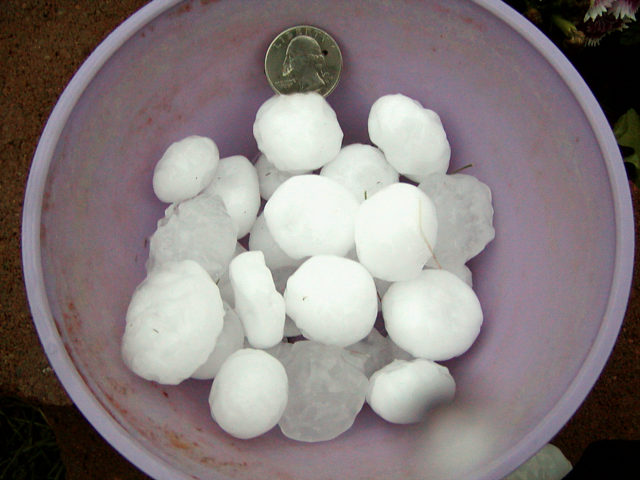|
Real-time reports are critical in issuing warnings and saving lives. That’s an indisputable fact! Spotters provide real-time ground-truth of local conditions, such as hail size, wind speed, tornado development, and local damage, to help warn the public. Even as new technology allows the National Weather Service to issue warnings with greater lead time, spotters will always serve as a critical link between radar indications of severe weather and what’s happening on the ground. |
|
|
Who are spotters? Virtually every community has some form of spotter network. Often, local fire and police personnel are trained to observe and report severe weather, partly due to their extensive radio communication and 24-hour operations. Citizens may also be an active part of the spotter network, some with an avid interest in the weather and many without. Some spotters are amateur radio operators. All share a sense of responsibility to their neighbors. What is Skywarn? SKYWARN is a program sponsored by the National Weather Service. The program is made up of thousands of volunteers who attend regular training and then scan the skies of their communities identifying and reporting critical storm information. These volunteers, sometimes organized under the SKYWARN banner in the U.S., are typically trained by NWS forecasters to be the eyes and ears of both the warning forecasters and the local public safety networks. |
 |
|
|
||
|
Important points to remember during severe weather:
|
 |
||||||
|
|
|||||||
|
|
Q. What is a storm spotter? A. The National Weather Service's (NWS) primary mission is to save lives and protect property through the issuance of warnings for hazardous weather. The WSR-88D Doppler Weather Radar is a great tool for detecting and tracking potentially severe storms and essentially all strong and violent tornadoes. However, NWS meteorologists also depend on real-time reports from trained spotters to know exactly what is occurring on the ground under a storm. The NWS trains people to identify severe storms and tornadoes and report them via organized communications networks (primarily local and county emergency management, law enforcement and amateur radio). Q. What is the difference between a storm spotter and a storm chaser? A. A storm spotter is volunteer or paid county or municipal employee who is spotting as a community service. Most spotters work as part of an organized network and are in communication with their community or organization, which is in turn in communication with the NWS. Some spotters are "mobile" spotters in vehicles, but most spot from fixed, strategic locations around the community or county. The purpose of spotting is to alert community officials and the NWS and assist them in warning the public. Schools, hospitals, and other facilities are encouraged to have spotters to alert people in their care of impending severe weather. Storm chasing involves following a developing thunderstorm to view or photograph severe weather phenomena. Chasing may be done for educational purposes or scientific research but is mostly done for personal fulfillment. Q. I want to be a storm chaser. What should I do? A. Q. How do I become a spotter? A. Attend a basic tornado and severe weather spotter class. Classes are held throughout the area, they are free and open to the public. The class takes about 1 ½ to 2 hours. Most classes are held weekday evenings, but there are a few daytime and Saturday classes. The training is generally done in late winter and early spring - before severe weather season. The training consists of a slide and video program which teaches potential spotters about severe storm structure, and how to identify cloud features and other environmental clues to identify severe storms and tornadoes. Communications systems and spotter networks are explained so the spotter knows where to report, and how that information is used by the NWS and local officials. A complete schedule of classes can be found on our website from about late January through April. Q. Is there a minimum age requirement to become a spotter? A. Because of the complexity of severe thunderstorm structure and development, and the potential danger involved, spotting is recommended for adults. People of all ages attend spotter training classes. Those ages 10 and up are likely to get the most from the class. Youth who are interested in attending a spotter training class are welcome to attend with a parent or other adult. Q. I have already taken a spotter class. Where can I learn more? A. The National Weather Service encourages spotters to be retrained every 2 years. In addition, spotters can attend the Advanced Severe Weather Spotter Workshop at Q. Does the NWS issue a certificate or spotter ID number? A. The NWS does not issue spotter ID numbers. Certificates are available on request. Some county emergency management agencies issue IDs and/or certificates. Please check with your local officials. Q. Does the NWS have any training material? A. In the past, the NWS has been able to hand out copies of the Basic Spotters' Field Guide. However, due to limited printing this year, the NWS has made the Field Guide available online. You can find it at: https://www.weather.gov/media/lot/spotter/basicspotterguide.pdf. There is also a version of the Weather Spotter's Field Guide in Spanish too.
|
|